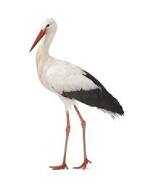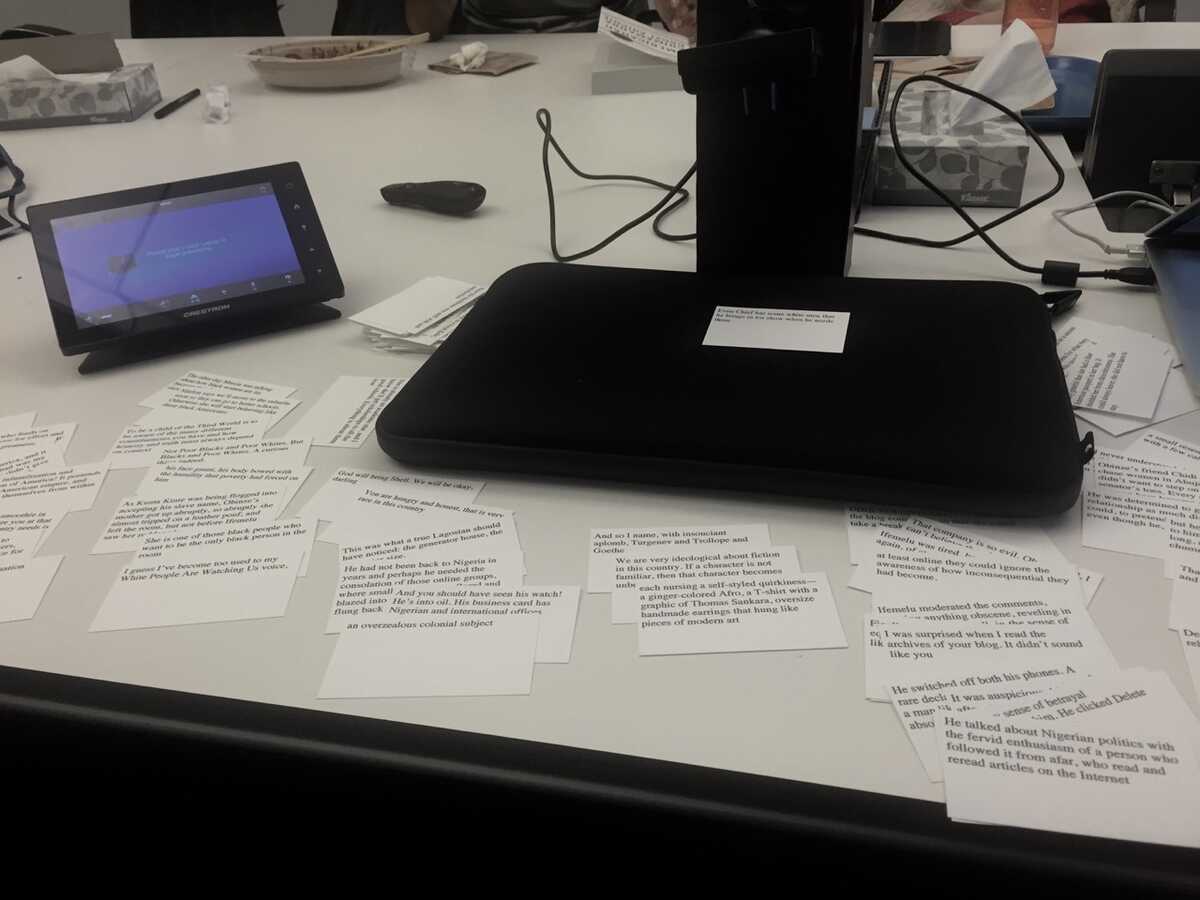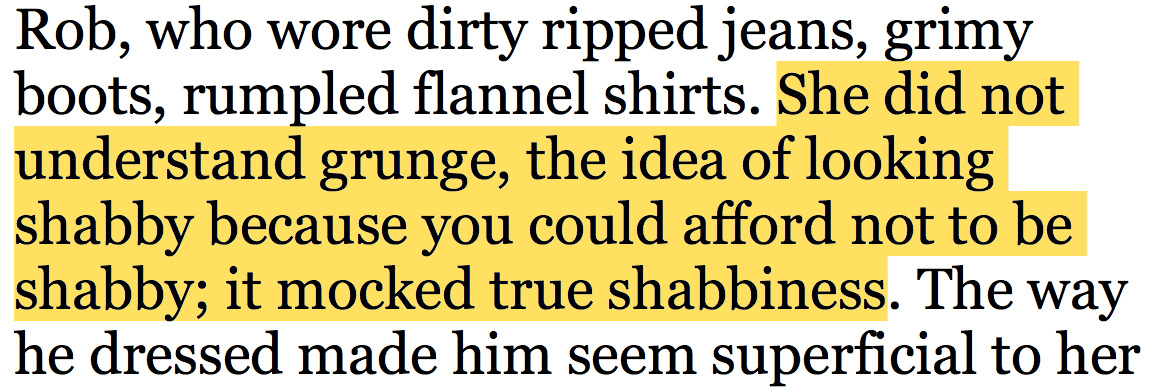Glen asked for me to send a journal entry about “how it went.” Here goes.
This is a panorama from my vantage point of the Stork ( ) conference room at Twitter HQ, as Book Club was winding down:
) conference room at Twitter HQ, as Book Club was winding down:
 ) conference room at Twitter HQ, as Book Club was winding down:
) conference room at Twitter HQ, as Book Club was winding down:
I was able to hook up my laptop to the big TV, where pages were crisp and legible for all seven participants, in normal lighting. In general, set-up was painless. The white table threw my contour detection in a slight tizzy—I had purchased black foam-core that I thought I’d need, but the CDG wooden tables gave me a false confidence—so I had to use my laptop sleeve as a background, which was slightly unfortunate (bigger than it needed to be).
As technology, it “worked” in that, with one exception, it always took me to the right part of the book in a timely manner. And even the time it didn’t work, since it was just iBooks, I could easily search manually for the quote and find it, so it wasn’t really a big deal. Generally, the mechanism of how these cards summoned pages on the TV was not present, and didn’t get in the way. It didn’t feel like I was using my computer.


On the other hand, since I had been spending so much of my focus preparing the technology, I hadn’t actually given very much thought to how I would use it. So I was confronted, at first, with 137 business cards in no particular order. Someone would say something and I would know I had a good card, but I couldn’t find it as quickly as I expected. I ended up spending a good 15 or 20 minutes, as everyone else was eating their Twitter dinners and giving first impressions of the book scrambling to get some order to my cards. This was a little embarrassing, but I persisted.
I ended up making rough thematic piles. At first the piles didn’t have names and were more like associations—I found some very impressive literary parallels that I hadn’t noticed while reading linearly—but eventually they gained intuitive names in my head (“America,” “Nigeria,” “Race,” “Relationships,” “Blogs/technology,” “Gender,” “Art/literature”) and by the time I had my sections, I had a very good mental-physical map of what I had, and where it was on the table. While I was sorting, I made a pile of about 1/3 of my highlights that were disconnected and I didn’t think I’d be able to bring up, and then about 10 highlights that didn’t fit into any of the categories, but were too beautiful for me to stack in “Other.”

Spreading everything out to organize it felt “natural,” and I can only imagine the pain of trying to do the same on the Tiny Rectangle. It might have been interesting to add a little bit of context and a yellow highlight to the cards, to give them more distinct highlight-shapes, but in general by the time I had categories I was able to find things very effectively.

…but to what end?
I experimented with many ways of using the cards throughout the evening, but—& this is confirmed in a quick debrief with book club organizer Diyang (in CC, and pictured above with disembodied panorama-hand)—clearly the overwhelming effect of my attempts to use this system was that I seemed “distracted.” And indeed probably my strongest contributions to the conversation were when I looked up from my business cards and just spoke, referring to parts of the book willy nilly without any effort to legitimate my characterizations with source material. Still, there were several moments when someone brought up an obscure thing they noticed, and were met with glazed over eyes. Sometimes, I had noticed the same thing, and was able to immediately bring it up and read the relevant paragraph. For instance, (& meta-ironically), from my not-in-a-category-but-too-beautiful-to-discard pile, the highlight “Did things begin to exist only when they were named?” actually came up in conversation, and I’m pretty sure that nobody but the person who mentioned it and myself recalled it before it was on the screen. There were several other moments when the cards helped me “get everyone on the same page” (sorry!) with a part of the book. Diyang made the point that maybe if we were engaging in a more literary analysis, then this sort of usage would have been more essential.
Another thing I did was pull up tangentially-related, or even contradictory quotes without saying anything while other people were talking. Sometimes someone would see it and look over at me to catch my eye in appreciative comprehension, but I think those “interventions” mostly dissolved into the ether.
A lot of the conversation focused on the morality, likability, and believability of the characters. This was not something I was particularly focused on when I was reading, so I didn’t have much business card “evidence” to contribute one way or another. I would sometimes pull a meta card from the “Art/literature” pile in silent protest (“We are very ideological about fiction in this country. If a character is not familiar, then that character becomes unbelievable”), but I am new to the idea of book club, and started drifting towards existential questions about why we were all in the Stork conference room[0] together talking about the book. Was it so we could talk about ourselves in relation to the characters—to judge our own morality in relation to the heroes, villains, and postmodern, or “complicated,” characters? Are we students of language eager for literary tricks and inspiration for code comments and business e-mails? Or could the books function as a lens into contemporary politics, the book club as a potential incendiary cell of social and political resistance that could be activated at any moment by a particularly biting highlight? Were we just there for the free startup dinner, and as a deadline/reward for “finishing” something?
It’s obvious that these cards would be very useful for someone doing any form of literary/academic research or writing. And I’d also wager that a professor could use them in lieu of a powerpoint/chalkboard for a great dynamic lecture. Finally, I think the book club dynamics would have been very different if everyone, not just me, had brought in their highlights to share.
In any case, I’m excited to see how something like this will work for video, and printing things out definitely takes my snippet collecting to the next level.
Your correspondent,
R.M.O.
[0] …and what it means for Twitter employees, or CDG researchers for that matter, to read books. Still a fascinating part of the club’s premise that I’m not quite beyond.
On May 6, 2015, at 5:42 PM, Robert M Ochshorn wrote:Now the Americanah business cards are “links in the world” back to their context in an e-book.<IMG_1476.jpeg>Continuing the spirit of video documentation, Glen helped me record a short demo (1min 41sec):I used the same Exemplar SVM classification technique as I was using in the LA exhibition. I had trouble using a logitech webcam due to auto-exposure, but the ps3-eye worked fine. (Though tweaking exposure is still, well, tweaking.)<Screen Shot 2015-05-06 at 2.59.36 PM.png>Unlike with the LA project, this does not require a precise alignment of the cards. Instead, I find the four corners of the card (using heuristics from a threshold-contour) and apply a perspective unwarp (I do expect them to be face up, plus or minus 45 degrees). Also unlike the LA project, I trained the classifier on the perfect digital versions of the business cards (i.e. the PDF that was printed), rather than camera images:<000038.png><000026.png>That saved a significant amount of time, and it seems to work just as well.The computer vision code can recognize several cards simultaneously, but I didn’t figure out what I would do with that sort of input data:<Screen Shot 2015-05-06 at 2.15.46 PM.png><Screen Shot 2015-05-06 at 2.27.06 PM.png>Finally, at Glen’s suggestion, I used Applescript/iBooks for the computer re-integration. The script is simple—it just hits Cmd+f and types in the text from the card—but I don’t know how long iBooks is going to take before I can hit “down, return” and its search is sometimes quite slow, so I wait three seconds, which is annoying:activate application "iBooks"tell application "System Events"key code 3 using {command down} -- command+fkeystroke "his body bowed with the humility that poverty had forced on him"delay 3key code 125 -- down arrowkey code 36 -- returnend tellI will bring it to Twitter Book Club now… let’s see if it can be part of a conversation, not its subject.-R.M.O.On May 5, 2015, at 5:43 PM, Robert M Ochshorn wrote:On May 5, 2015, at 5:40 PM, Robert M Ochshorn wrote:tweet-length highlights from AmericanaAmericanah (@#*&@#(*$ autocorrect).Also, they are tweet-length highlights because I will bring them to the Twitter book club tomorrow.… maybe with some peek-quotes projector-camera magic-rmo